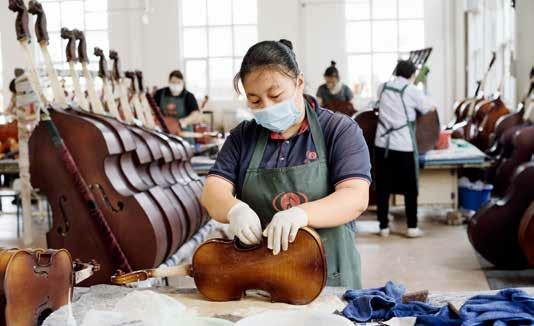Crescendo in Violin Town
2020-08-10byQinBin
by Qin Bin


For many, attending an inter- national concert can be a big deal. But such events are already common for residents of Donggaocun Town in Pinggu District, Beijing. In August 2019, musicians including violinist Jose Vicente and classical guitarist Miguel Perez from Spains Orchestra of Valencia visited Donggaocun to participate in a week of musical and cultural exchange activities. Music lovers from around China joined locals to enjoy a high-end music feast. Known across China as the“Violin Town,” Donggaocun has been gradually evolving from a musical instrument production base to a hub of cultural and art exchanges.
About 70 kilometers away from downtown Beijing, Donggaocun has been manufacturing violins for more than 30 years. By 2009, the towns annual production of violins had already reached 200,000 pieces. The musical instruments were exported to more than 30 countries and regions on the globe, accounting for nearly 30 percent of the worlds violin production. In recent years, operations have expanded to include more musical instruments such as the erhu (a two-stringed musical instrument), upright bass, and acoustic guitar.
In recent years, Donggaocun has been striving to explore the international market, reduce the product volume while improving quality, increase added value, and shift to medium- and high-end production, away from low-end. Located in the town, Beijing Huadong Musical Instrument Co., Ltd., established in 1988, is the largest violin manufacturer in northern China. It produces violins, violas, cellos, basses, and erhus.
“There was a time when Donggaocun had produced one out of every three violins in the world,” notes Liu Yundong, chairman of the company. “But in those days, most of the violins we produced were low-end and priced at about US$14 to 28. Now, Pinggu-produced violins sell for as much as US$11,300. A number of renowned violinists including Elmar Oliveira own violins from Pinggu as spares.”
Liu Zunfei, a graduate of the Central Conservatory of Music, one of Chinas top institutions for music education, now works for Beijing Huadong Musical Instrument Co., Ltd. The millennial considers violin making an art that should focus more on quality than quantity. It usually takes more than 60 days to make a decent violin.
“Nowadays, violin making is more environmentally-friendly,”says Liu. His company uses plant extracts and Chinese medicinal herbs such as shellac, jasmine, and lavender in its alcohol-based and oil-based paints to stay benzenefree. This enabled them to eliminate the chemical paint that was previously used on the surface.“The process takes a bit longer, but paints made of natural plants arent harmful to either the environment or the violin makers.”
In addition to actively carrying out international and domestic music exchange activities, the violin cultural industry in Donggaocun has been expanding in recent years from violin production to a wider array of musical sectors including education and training, performance, and offering violin making experiences. The traditional violin making industry in the town has been quick to integrate with tourism, performance, and leisure, among other cultural industries.
All elementary schools in Donggaocun feature a dedicated violin room stocked with donated violins. The town has invited more than 50 music educators and artistic consultants from renowned Chinese institutions of higher education to lecture.
“Thirty years ago, many in Donggaocun could make violins but few could play the instrument,” Liu says. “Today, many local children can play quite well. We are fully confident in our future.”
